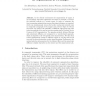Free Online Productivity Tools
i2Speak
i2Symbol
i2OCR
iTex2Img
iWeb2Print
iWeb2Shot
i2Type
iPdf2Split
iPdf2Merge
i2Bopomofo
i2Arabic
i2Style
i2Image
i2PDF
iLatex2Rtf
Sci2ools
BILDMED
2008
2008
Edge-Preserving Denoising for Segmentation in CT-images
In the clinical environment the segmentation of organs is an increasingly important application and used, for example, to restrict the perfusion analysis to a certain organ. In order to automate the time-consuming segmentation process denoising techniques are required, which can simultaneously remove the locally varying and oriented noise in computed tomography (CT) images and preserve edges of relevant structures. We analyze the suitability of different edge-preserving noise reduction methods to be used as a pre-processing step for Geodesic Active Contours (GAC) segmentation. Two popular methods, bilateral filtering and anisotropic diffusion, are compared to a wavelet-based approach, which is adjusted to the CT-specific noise characteristics. We show that robust segmentation results for different organs at varying noise levels can only be achieved using the wavelet-based denoising. Furthermore, the optimal selection of parameters for the bilateral filter and the anisotropic diffusion ...
Algorithms | Anisotropic Diffusion | BILDMED 2008 | CT-specific Noise Characteristics | Time-consuming Segmentation Process |
| Added | 29 Oct 2010 |
| Updated | 29 Oct 2010 |
| Type | Conference |
| Year | 2008 |
| Where | BILDMED |
| Authors | Eva Eibenberger, Anja Borsdorf, Andreas Wimmer, Joachim Hornegger |
Comments (0)

